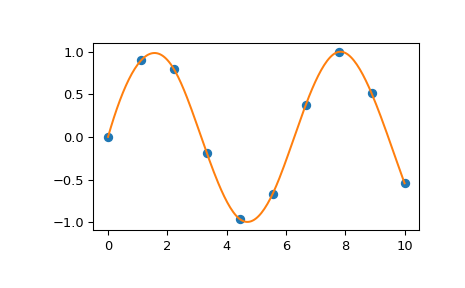splrep#
- scipy.interpolate.splrep(x, y, w=None, xb=None, xe=None, k=3, task=0, s=None, t=None, full_output=0, per=0, quiet=1)[source]#
Find the B-spline representation of a 1-D curve.
Legacy
This function is considered legacy and will no longer receive updates. While we currently have no plans to remove it, we recommend that new code uses more modern alternatives instead. Specifically, we recommend using
make_splrepin new code.Given the set of data points
(x[i], y[i])determine a smooth spline approximation of degree k on the intervalxb <= x <= xe.- Parameters:
- x, yarray_like
The data points defining a curve
y = f(x).- warray_like, optional
Strictly positive rank-1 array of weights the same length as x and y. The weights are used in computing the weighted least-squares spline fit. If the errors in the y values have standard-deviation given by the vector
d, then w should be1/d. Default isones(len(x)).- xb, xefloat, optional
The interval to fit. If None, these default to
x[0]andx[-1]respectively.- kint, optional
The degree of the spline fit. It is recommended to use cubic splines. Even values of k should be avoided especially with small s values.
1 <= k <= 5.- task{1, 0, -1}, optional
If
task==0, findtandcfor a given smoothing factor, s.If
task==1findtandcfor another value of the smoothing factor, s. There must have been a previous call withtask=0ortask=1for the same set of data (twill be stored an used internally)If
task=-1find the weighted least square spline for a given set of knots,t. These should be interior knots as knots on the ends will be added automatically.- sfloat, optional
A smoothing condition. The amount of smoothness is determined by satisfying the conditions:
sum((w * (y - g))**2,axis=0) <= swhereg(x)is the smoothed interpolation of(x,y). The user can use s to control the tradeoff between closeness and smoothness of fit. Larger s means more smoothing while smaller values of s indicate less smoothing. Recommended values of s depend on the weights, w. If the weights represent the inverse of the standard-deviation of y, then a good s value should be found in the range(m-sqrt(2*m),m+sqrt(2*m))wheremis the number of datapoints in x, y, and w. default :s=m-sqrt(2*m)if weights are supplied.s = 0.0(interpolating) if no weights are supplied.- tarray_like, optional
The knots needed for
task=-1. If given then task is automatically set to-1.- full_outputbool, optional
If non-zero, then return optional outputs.
- perbool, optional
If non-zero, data points are considered periodic with period
x[m-1]-x[0]and a smooth periodic spline approximation is returned. Values ofy[m-1]andw[m-1]are not used. The default is zero, corresponding to boundary condition ‘not-a-knot’.- quietbool, optional
Non-zero to suppress messages.
- Returns:
- tcktuple
A tuple
(t,c,k)containing the vector of knots, the B-spline coefficients, and the degree of the spline.- fparray, optional
The weighted sum of squared residuals of the spline approximation.
- ierint, optional
An integer flag about splrep success. Success is indicated if
ier<=0. Ifier in [1,2,3], an error occurred but was not raised. Otherwise an error is raised.- msgstr, optional
A message corresponding to the integer flag, ier.
See also
Notes
See
splevfor evaluation of the spline and its derivatives. Uses the FORTRAN routinecurfitfrom FITPACK.The user is responsible for assuring that the values of x are unique. Otherwise,
splrepwill not return sensible results.If provided, knots t must satisfy the Schoenberg-Whitney conditions, i.e., there must be a subset of data points
x[j]such thatt[j] < x[j] < t[j+k+1], forj=0, 1,...,n-k-2.This routine zero-pads the coefficients array
cto have the same length as the array of knotst(the trailingk + 1coefficients are ignored by the evaluation routines,splevandBSpline.) This is in contrast withsplprep, which does not zero-pad the coefficients.The default boundary condition is ‘not-a-knot’, i.e. the first and second segment at a curve end are the same polynomial. More boundary conditions are available in
CubicSpline.Array API Standard Support
splrepis not in-scope for support of Python Array API Standard compatible backends other than NumPy.See Support for the array API standard for more information.
References
Based on algorithms described in [1], [2], [3], and [4]:
[1]P. Dierckx, “An algorithm for smoothing, differentiation and integration of experimental data using spline functions”, J.Comp.Appl.Maths 1 (1975) 165-184.
[2]P. Dierckx, “A fast algorithm for smoothing data on a rectangular grid while using spline functions”, SIAM J.Numer.Anal. 19 (1982) 1286-1304.
[3]P. Dierckx, “An improved algorithm for curve fitting with spline functions”, report tw54, Dept. Computer Science,K.U. Leuven, 1981.
[4]P. Dierckx, “Curve and surface fitting with splines”, Monographs on Numerical Analysis, Oxford University Press, 1993.
Examples
You can interpolate 1-D points with a B-spline curve. Further examples are given in in the tutorial.
>>> import numpy as np >>> import matplotlib.pyplot as plt >>> from scipy.interpolate import splev, splrep >>> x = np.linspace(0, 10, 10) >>> y = np.sin(x) >>> spl = splrep(x, y) >>> x2 = np.linspace(0, 10, 200) >>> y2 = splev(x2, spl) >>> plt.plot(x, y, 'o', x2, y2) >>> plt.show()
